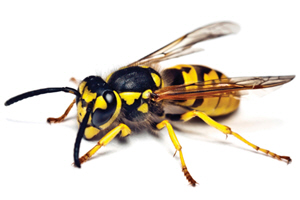
“I was minding my own business, mowing my lawn when all of a sudden, I’m being attacked by yellowjackets.”
Does this sound familiar? Contra Costa County residents often share stories like this when a Contra Costa Mosquito & Vector Control District employee arrives to provide residential ground-nesting yellowjacket service. This year, they are stories that we’re hearing more often.
So far this year, the number of ground-nesting yellowjacket service requests that the District has received has surpassed last year’s number by 21 percent as well as the average for the last five years by 74 percent.
That’s left residents and District employees alike to wonder why are there so many yellowjackets this year?
“The mild winter may have allowed more hibernating queens to survive. Then, the late season rains provided plenty of vegetation for the smaller insects that the yellowjackets will feed on. The combination has left us with a bumper crop of yellowjackets this summer,” says the District’s Scientific Programs Manager Steve Schutz, Ph.D.
What to do if you encounter a ground-nesting yellowjacket nest on your property
- First and foremost, if the yellowjackets are biting and stinging you, remove yourself from the location.
- Once you are out of the yellowjackets’ path, draw a rough map of the yard, pointing out the location of the nest, so that the District employee who responds to the request will know where to look.
- Place the map on the front door or front gate.
- Contact the District for ground-nesting yellowjacket service by calling 925-685-9301 or by visiting our website.
Once you have requested the District service, do not attempt to do anything to the nest. The nest must be dry and untreated should the District need to treat it.
The District does not make appointments. Once we receive a request, we will respond within five business days.
image: courtesy of the Contra Costa Mosquito & Vector Control District

Someone in my neighborhood has a nest. I had one a few years ago. I sprayed it and covered it with a lot of dirt. Seemed to have worked. I was so fast they didn’t touch me. I think if you hang a trap you will attract more.
I have had great success hanging traps early in the season and catching the queens. No queen, no colony.
You can also kill the underground colonies by putting dry ice around the hole. The CO2 will go down the hole (it’s heavier than air) and suffocate them. Obviously, this works better if there’s no wind.
My wife and I were both stung (separate times) in our front yard.
Had a ground nest that was within our hedge (hard to see visually and destroy). Luckily, Concord Mosquito and Vector control came (FREE program – my taxes are finally being used for a service I need) and wiped the Yellow jackets out.
I received quotes between $150 – $285 for a one-time visit.
I agree that traps seem to attract more of whatever it is you are trying to trap.
All creatures have a preferred environment, not too hot nor too cold. not too wet nor too dry. My strategy for dealing with yellow jackets, which live in the ground, is to make it too wet and then too dry. At night, when they are sleeping, I set the hose out and give the area of the nest a through soaking.I then pack sand into the openings. The sand will dry out and make the nest itself too dry to be usable. I repeat that for two or three nights until there is no evidence of yellow jacket activity.
Paper wasps look like yellow jackets but build the nests that you see hanging from the eaves and in bushes. Paper wasps are very docile and beneficial to the garden. I leave them and their nests alone. If they they build a nest in one of your walls or attic space then dust the openings. You can get the dust at any hardware store. Later you can seal the openings.
I didn’t know this, thanks for the info. I just looked them up to see the difference and all this time I thought it was yellow jackets I see around the house when they are in fact paper wasps. Thinking they were yellow jackets, I always knocked down their nests, now I think I will leave them alone.
This is a great, did I mention free? service. I’ve used it twice over the last few years. Effective and safe. Use it. As Grant noted above you will be happy to get some direct benefit from those taxes you’ve been complaining about.
Even if it’s a free service (taxpayer funded) I like to take care of problems myself. I have destroyed one ground yellowjacket nest in the past with a shovel and a can of wasp spray. The secret was doing it in complete darkness when they can’t fly and sting you. I’m sure the Vector people hate to think that someone else can do a govmint trained job
If you have access to it. Destroyed many a nest myself and had fun doing it. But, had a nest last year that was tough to access at the base of a bush and next to the house. Must have tried 4 cans of wasp spray as well as drowning with a hose – nothing. Called Vector Control, they were out w/i 2 days. They have a special killer foam. Worked like a charm. Haven’t seen a yellow jacket since. Absolute way to go – for FREE! Only ground nests though. VC won’t deal with nests w/i structures.
Thankfully I’ve never had a problem with yellow jackets. Can recall only spotting 2 this summer in my gardens.
Also, bee activity overall this summer is really down compared to prior years.
The District also provided a free service to inspect your property for rodent issues. The won’t trap, but will point out areas of possible concern.
Squirt some Tempo dust from a bottle in the entrance at night. Done. Sprays during the day only got me stung.
I found one on the walkway to one of my customers homes a few years ago. I let everyone at the job know so they could avoid the nest. Later a security company installing an alarm showed up and when they were done stuck their free sign right in the nest. He was rewarded with numerous bites. I offered him a decongestant, because I was told that when you are bitten by several bees, it is the histamine that swells up and causes the most discomfort. He said no, so no it was.
I can’t recommend it nowadays, but when I was a kid back east the local yokels would poor diesel fuel down the hole. They also used diesel as a weed killer and God knows what else. I guess it was crazy cheap. And apparently, effective.
Atticus Thraxx – My late father-in-law ‘recycled’ oil when he changed the household car’s oil. How? The oil was thrown into the front yard juniper bushes. Apparently with no I’ll effect to the bushes.
Different world we live in today for sure.
we did the same with kerosene, but dumped sand on it right way then a touch more kerosene on top and took a match to it… old oil was always dumped behind the shed for weed control… ah for the good old days…
S we did the same thing. Nothing will grow on our old patch for a thousand years. Mary, if you guys ever made gin out of his juniper berries,I bet that’d pack a punch. My mom and dad were pretty good about disposing of stuff. Which means it all probably went in the trash can instead of the sewer.
I’ve wiped out a couple of ground nests by waiting till after dusk when they’re in for the night, setting off a flea bomb pointing it down into the hole, and packing rags around the can if it doesn’t fit snugly. The next day you fill in the hole with sand so a new yellow-jacket family doesn’t move right on in. I have been attacked by a large swarm of them after my mom dug up a nest and yelled for me (eleven years old at the time[!?!😭?!?]) to come help her. I ran back out of the cloud and they mostly stayed there. It was painful and annoying.
We have yellow jackets everywhere, but we can’t locate the nest. Any suggestions on how to find it would be appreciated. They are not coming from one place and keep flying in circles.
If you can locate the Nest entrance, here is how you get rid of them.At night when they aren’t active You sneak up to the nest and Dump a Half Gallon of Gasoline down the Hole.Thats it ..Dont light it either.
Hello again folks, I can help with this one… we have been outdoor people for years and have suffered the scorn of the dreaded yellow jackets…
1) if you must eat outside leave a small sampling of your food on a plate a
a bit of a distance from yours and they will congregate there…
2) the obvious yellow jacket traps also work well in the same concept..
3) years ago during the drought, we witnessed horrible amounts of the little
Devils around our campsite. Our astute neighbor told to use a few sheets
of bounce at the picnic table and it worked….
Berryman B12 carburetor cleaner is fast and effective. And it’s low VOC!